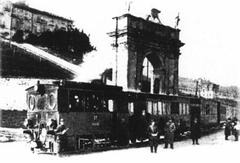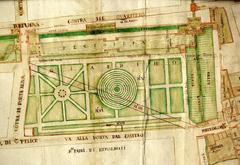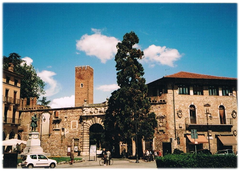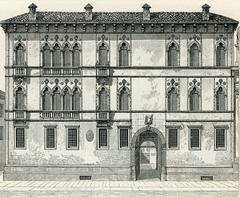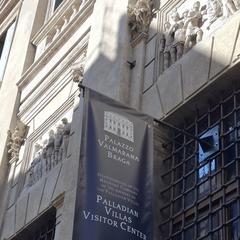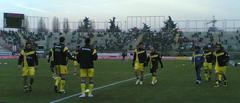Santa Corona Visiting Hours, Tickets, and Historical Sites in Vicenza
Date: 17/08/2024
Introduction
Santa Corona in Vicenza, Italy, stands as a monumental testament to the city’s rich historical and cultural legacy. Constructed in the 13th century, this Gothic church was originally built to house a holy relic—a thorn from Christ’s Crown of Thorns, gifted by French King Louis IX to the Bishop of Vicenza, Bartolomeo da Breganze (Planetware). Over centuries, Santa Corona has evolved, incorporating Renaissance elements and housing significant artworks, such as Giovanni Bellini’s ‘Baptism of Christ’ and Paolo Veronese’s ‘Adoration of the Magi’ (Planetware). The church is also closely associated with Andrea Palladio, whose architectural influence is evident in the Valmarana Chapel and other parts of the church (Planetware). Today, Santa Corona is not just a place of worship but a cultural landmark and a repository of Renaissance art, attracting visitors from around the globe. This guide will provide you with comprehensive information on its historical significance, visiting hours, ticket prices, and tips to make your visit enriching and memorable.
Table of Contents
- Historical Background of Santa Corona, Vicenza
- Visitor Experience
- Artistic Highlights of Santa Corona, Vicenza
- Giovanni Bellini’s ‘Baptism of Christ’
- Paolo Veronese’s ‘Adoration of the Magi’
- Gianbattista Pittoni’s ‘Enthroned Madonna and Child’
- Michelino da Besozzo’s Frescoes
- Marcello Fogolino’s ‘Madonna of the Stars’
- Bartolomeo Montagna’s ‘St Mary Magdalen with Saints Jerome, Paola, and Monica’
- Leandro Bassano’s ‘St Anthony and Friars Distributing Alms to the Poor’
- Battista da Vicenza’s Canvases
- Statues of Dominican Saints
- Valmarana Chapel
- How to Visit Santa Corona in Vicenza: Hours, Tickets, and Tips
Historical Background of Santa Corona, Vicenza
13th Century Origins
The Gothic church of Santa Corona in Vicenza, Italy, was constructed in the 13th century. It was built to house a significant holy relic—a thorn from Christ’s Crown of Thorns. This relic was a gift from the French king Louis IX to the Bishop of Vicenza, Bartolomeo da Breganze, who initiated the church’s construction. The church’s foundation stone was laid in 1261, and it was consecrated in 1270. The architectural style of Santa Corona is predominantly Gothic, characterized by its pointed arches, ribbed vaults, and flying buttresses, which were typical of ecclesiastical buildings of that era.
Renaissance Influence
Santa Corona is not only a place of worship but also a repository of significant artworks and architectural marvels. One of the most notable features is the Cappella Valmarana, a chapel believed to have been designed by Andrea Palladio, one of the most influential architects of the Renaissance. Palladio’s work in Vicenza has been recognized by UNESCO, which cited his contributions as giving the city its unique appearance (UNESCO citation). The chapel was completed in 1576, and Palladio himself is buried in the church, adding to its historical and cultural significance.
Art and Relics
Santa Corona houses several notable paintings that attract art enthusiasts from around the world. Among these is the “Baptism of Christ” by Giovanni Bellini, dating back to around 1500, located above the fifth altar on the left. Another significant artwork is the “Adoration of the Magi” by Veronese, found on the third altar on the right (Planetware). These masterpieces are exemplary of the Venetian school of painting, which flourished during the Renaissance and significantly influenced European art.
Historical Events
The church has witnessed numerous historical events over the centuries. During the Venetian rule from 1404 to the late 1700s, Vicenza, including Santa Corona, became a melting pot of Venetian and Palladian architectural styles. This period was marked by significant cultural and artistic exchanges, which are evident in the church’s design and artworks. The church also survived the tumultuous periods of the Napoleonic Wars and the unification of Italy, maintaining its status as a significant religious and cultural landmark.
Preservation and Restoration
Over the years, Santa Corona has undergone several restoration projects to preserve its architectural integrity and artistic treasures. One of the most significant restorations took place after World War II, during which the church suffered damage. The restoration efforts focused on repairing the structural damage and restoring the artworks to their original glory. These efforts have ensured that Santa Corona remains a vital part of Vicenza’s cultural heritage.
Influence of Andrea Palladio
Andrea Palladio’s influence on Santa Corona extends beyond the Cappella Valmarana. Palladio’s architectural principles, which emphasized symmetry, perspective, and the use of classical elements, are evident in various parts of the church. His work in Vicenza, including Santa Corona, inspired the Palladian architectural style, which spread to England, other European countries, and North America (Planetware). Palladio’s designs for Santa Corona and other buildings in Vicenza have been instrumental in shaping the city’s architectural landscape.
Cultural and Religious Significance
Santa Corona holds immense cultural and religious significance for the people of Vicenza and beyond. The church is a pilgrimage site for those who wish to venerate the holy relic of the thorn from Christ’s Crown of Thorns. It also serves as a venue for various religious ceremonies and cultural events, making it a vibrant part of the community. The church’s rich history and artistic heritage make it a must-visit destination for tourists and scholars alike.
Visitor Experience
Visitors to Santa Corona can explore its rich history and artistic treasures through guided tours and informational displays. The church’s serene atmosphere and stunning architecture provide a unique experience for those interested in Gothic and Renaissance art and architecture. The church is located at Contra Sant Corona 2, Vicenza, making it easily accessible for tourists exploring the city’s other attractions (official site).
Visitor Information
Visiting Hours: Santa Corona is open to visitors from 9:00 AM to 5:00 PM on weekdays and from 10:00 AM to 4:00 PM on weekends.
Tickets: Admission to the church is €4 for adults and €2 for children and seniors. Guided tours are available for an additional fee.
Accessibility: The church is accessible to visitors with mobility issues, with ramps and elevators available.
Nearby Attractions
Visitors to Santa Corona can also explore nearby attractions such as the Teatro Olimpico, another masterpiece by Andrea Palladio, and the Basilica Palladiana, a Renaissance building that offers stunning views of Vicenza. Both sites are within walking distance from Santa Corona.
Travel Tips
When visiting Vicenza, it is recommended to wear comfortable walking shoes as the city is best explored on foot. Consider purchasing a Vicenza Card, which offers discounted entry to multiple historical sites, including Santa Corona.
FAQ
Q: What are the visiting hours for Santa Corona?
A: The church is open from 9:00 AM to 5:00 PM on weekdays and from 10:00 AM to 4:00 PM on weekends.
Q: How much are tickets for Santa Corona?
A: Admission is €4 for adults and €2 for children and seniors. Guided tours are available for an additional fee.
Q: Are guided tours available at Santa Corona?
A: Yes, guided tours are available for an additional fee.
Q: Is Santa Corona accessible to visitors with mobility issues?
A: Yes, the church is accessible with ramps and elevators available.
Artistic Highlights of Santa Corona, Vicenza
Giovanni Bellini’s “Baptism of Christ”
One of the most significant artistic treasures housed in Santa Corona is Giovanni Bellini’s “Baptism of Christ,” a tempera painting on panel dating from 1500-1502. This masterpiece is located on the left (south) side of the nave. The painting is notable for its immersive tranquility and the smoothness of tones that tie together the landscape and the sky, enveloping the figures in light and atmosphere. The composition features Jesus at the center, turned toward the viewer, while John the Baptist, on the left, baptizes him. Three angelic figures, representing the theological virtues of faith, hope, and charity, await on the right. Above, God the Father appears among cherubs and seraphim, sending forth the dove of the Holy Spirit (Wikipedia).
Paolo Veronese’s “Adoration of the Magi”
Another highlight is Paolo Veronese’s “Adoration of the Magi,” which is highly praised by Goethe. This painting is celebrated for its light-filled composition and the intricate details that bring the scene to life. Veronese’s work is a testament to the grandeur of the Renaissance, capturing the moment when the Magi present their gifts to the infant Jesus. The painting is located in the Valmarana Chapel, designed by Andrea Palladio in 1576 (Lonely Planet).
Gianbattista Pittoni’s “Enthroned Madonna and Child”
In the Thiene Chapel, visitors can admire Gianbattista Pittoni’s “Enthroned Madonna and Child Venerated by Saints Peter and Pius V.” This altarpiece is a fine example of Pittoni’s skill in combining religious themes with a sense of grandeur and reverence. The composition features the Madonna and Child enthroned, surrounded by saints, creating a powerful visual narrative that draws the viewer into the spiritual realm (Wikipedia).
Michelino da Besozzo’s Frescoes
The Thiene Chapel also houses frescoes by Michelino da Besozzo, adding to the rich tapestry of art within Santa Corona. These frescoes depict various religious scenes and are notable for their vibrant colors and intricate details. Michelino da Besozzo was known for his delicate and expressive style, which is evident in the frescoes that adorn the chapel (Wikipedia).
Marcello Fogolino’s “Madonna of the Stars”
Marcello Fogolino’s “Madonna of the Stars” is another significant work within Santa Corona. This painting captures the ethereal beauty of the Madonna, surrounded by stars, symbolizing her divine nature. Fogolino’s use of light and color creates a sense of otherworldly grace, making this painting a must-see for visitors (Wikipedia).
Bartolomeo Montagna’s “St Mary Magdalen with Saints Jerome, Paola, and Monica”
Bartolomeo Montagna’s “St Mary Magdalen with Saints Jerome, Paola, and Monica” (1414-1415) is a remarkable canvas that depicts these saints in a moment of divine contemplation. Montagna’s attention to detail and his ability to convey the spiritual essence of his subjects make this painting a standout piece in the church’s collection (Wikipedia).
Leandro Bassano’s “St Anthony and Friars Distributing Alms to the Poor”
Leandro Bassano’s “St Anthony and Friars Distributing Alms to the Poor” (1518) is a powerful depiction of charity and compassion. The painting shows St Anthony and friars giving alms to the poor, highlighting the importance of generosity and kindness in Christian teachings. Bassano’s use of light and shadow adds depth to the scene, making it a compelling work of art (Wikipedia).
Battista da Vicenza’s Canvases
Santa Corona also features two canvases by Battista da Vicenza, depicting St Sebastian and St Martin. These paintings are notable for their dynamic compositions and the emotional intensity of the figures. Battista da Vicenza’s skill in capturing the human form and his use of dramatic lighting make these works a significant part of the church’s artistic heritage (Wikipedia).
Statues of Dominican Saints
In a small chapel off the sacristy, visitors can find a number of statues of Dominican saints, including that of Vincent Ferrer. These statues are finely crafted and serve as a testament to the Dominican order’s influence on the church. The presence of these statues adds to the spiritual atmosphere of Santa Corona, providing visitors with a deeper understanding of the church’s religious significance (Wikipedia).
Valmarana Chapel
The Valmarana Chapel, designed by Andrea Palladio between 1576 and 1580, is another artistic highlight of Santa Corona. This chapel was constructed as a funereal chapel for Isabella Nogarola Valmarana, following the death of her husband, Antonio Valmarana. Palladio’s design is reminiscent of his chapels found at Il Redentore in Venice, showcasing his mastery of Renaissance architecture. The chapel’s elegant proportions and harmonious design make it a fitting tribute to the Valmarana family (Wikipedia).
How to Visit Santa Corona in Vicenza: Hours, Tickets, and Tips
Location and Accessibility
The Church of Santa Corona is conveniently located near Piazza Matteotti in the historic center of Vicenza. This central location makes it easily accessible on foot, especially if you are exploring the city on a walking tour. The church is a short distance from other notable attractions, such as the Teatro Olimpico and the Basilica Palladiana, making it an ideal stop on your itinerary.
Santa Corona Visiting Hours and Admission
Santa Corona is generally open to visitors from Tuesday to Sunday, with typical visiting hours from 9:00 AM to 5:00 PM. However, it is advisable to check the official website or contact the local tourist information center for the most up-to-date information on opening hours, as they can vary depending on the season or special events.
Admission to the church is often free, but donations are appreciated to help with the maintenance and preservation of this historic site. Occasionally, there may be a small fee for special exhibitions or guided tours.
Best Time to Visit
To avoid the crowds and enjoy a more peaceful experience, consider visiting Santa Corona early in the morning or later in the afternoon. Weekdays are generally less crowded than weekends. If you are visiting during the peak tourist season (June to August), arriving early can also help you avoid the heat and make your visit more comfortable.
Guided Tours and Audio Guides
For a more in-depth understanding of the church’s history and significance, consider joining a guided tour. Many local tour operators offer comprehensive tours that include Santa Corona as part of a broader exploration of Vicenza’s historic center. Alternatively, audio guides are often available at the entrance, providing detailed information about the church’s architecture, artworks, and historical context.
Key Highlights to Explore
Frescoes and Paintings
Santa Corona is renowned for its stunning frescoes and precious paintings. Notable works include the “Baptism of Christ” by Giovanni Bellini and the “Adoration of the Magi” by Veronese. These masterpieces are a testament to the church’s rich artistic heritage and are a must-see for art enthusiasts.
Valmarana Chapel
Designed by the famous Renaissance architect Andrea Palladio, the Valmarana Chapel is one of the church’s architectural highlights. The chapel’s elegant design and intricate details reflect Palladio’s genius and offer a glimpse into the architectural innovations of the Renaissance period.
Crypt of Lorenzo da Bologna
The crypt of Lorenzo da Bologna is another significant feature of Santa Corona. This serene and contemplative space provides a stark contrast to the grandeur of the main church and offers visitors a moment of quiet reflection.
History and Cultural Significance
Santa Corona holds a special place in the history and culture of Vicenza. It was founded in the 13th century to house a relic of the Holy Thorn, hence its name ‘Santa Corona.’ Over the centuries, it has been a site of religious importance and a repository of priceless art and architecture. The church reflects the city’s rich cultural heritage and the artistic achievements of the Renaissance period.
Photography Tips
Photography is generally allowed inside Santa Corona, but it is important to be respectful of the sacred nature of the site. Flash photography is usually prohibited to protect the delicate artworks. For the best results, use a camera with good low-light capabilities or a smartphone with a night mode feature. Focus on capturing the intricate details of the frescoes and the architectural beauty of the chapels.
Nearby Attractions
After visiting Santa Corona, take some time to explore the surrounding area. The historic center of Vicenza is home to numerous other attractions, including:
- Teatro Olimpico: The world’s first indoor theater, designed by Andrea Palladio. (Places of Juma)
- Basilica Palladiana: A stunning example of Renaissance architecture located in Piazza dei Signori. (Places of Juma)
- Villa La Rotonda: Another Palladian masterpiece located just outside the city center. (Places of Juma)
Dining and Refreshments
Vicenza offers a variety of dining options to suit all tastes and budgets. After your visit to Santa Corona, consider stopping by one of the local cafés or restaurants for a meal or a refreshing drink. Some recommendations include:
-
Al Pellegrino: Located near the Basilica di Santa Maria, this charming restaurant offers excellent coffee and delicious desserts at reasonable prices. (Places of Juma)
-
Corso Palladio: The main shopping street in Vicenza, lined with numerous cafés and eateries where you can enjoy local specialties such as Baccalà alla Vicentina. (Places of Juma)
Accommodation
For those planning to stay overnight in Vicenza, there are several excellent accommodation options in the historic center. One highly recommended choice is the Relais Santa Corona, a wonderful B&B that offers comfortable rooms and a convenient location close to the church. (Places of Juma)
Practical Tips
- Dress Code: As Santa Corona is a place of worship, visitors are expected to dress modestly. Avoid wearing shorts, sleeveless tops, or revealing clothing. A shawl or scarf can be handy to cover your shoulders if needed.
- Respectful Behavior: Maintain a respectful demeanor while inside the church. Keep noise levels low, especially during services or when other visitors are praying.
- Safety: Vicenza is generally a safe city, but it is always wise to stay vigilant and keep an eye on your belongings, especially in crowded areas.
FAQ
- What are the visiting hours for Santa Corona?
- Santa Corona is generally open from Tuesday to Sunday, 9:00 AM to 5:00 PM. Check the official website for the most current hours.
- Are tickets required to visit Santa Corona?
- Admission is often free, but donations are appreciated. Occasionally, there may be a small fee for special exhibitions or guided tours.
- What is the best time to visit Santa Corona?
- Early mornings and late afternoons on weekdays are the best times to avoid crowds.
Visit and Stay Up to Date
By following these tips, you can ensure a memorable and enriching visit to Santa Corona, one of Vicenza’s most treasured landmarks. For more updates and information, download our mobile app Audiala, check out other related posts, or follow us on social media.
Conclusion
Santa Corona in Vicenza is a remarkable fusion of historical, architectural, and artistic significance. From its 13th-century Gothic origins to the Renaissance influences introduced by Andrea Palladio, the church encapsulates key periods in European history and art. Visitors can explore an array of masterpieces, including Bellini’s ‘Baptism of Christ’ and Veronese’s ‘Adoration of the Magi’, making it a must-visit for art enthusiasts (Planetware) (Lonely Planet). Practical information such as visiting hours, admission fees, and guided tours ensures that visitors can plan their trip effectively. The church’s central location in Vicenza also offers easy access to other attractions like the Teatro Olimpico and the Basilica Palladiana (Places of Juma). Whether you are a history buff, an art lover, or a spiritual seeker, Santa Corona promises a rich and fulfilling experience. Stay updated on visiting details and special events by visiting the Musei Civici Vicenza website or following them on social media.
